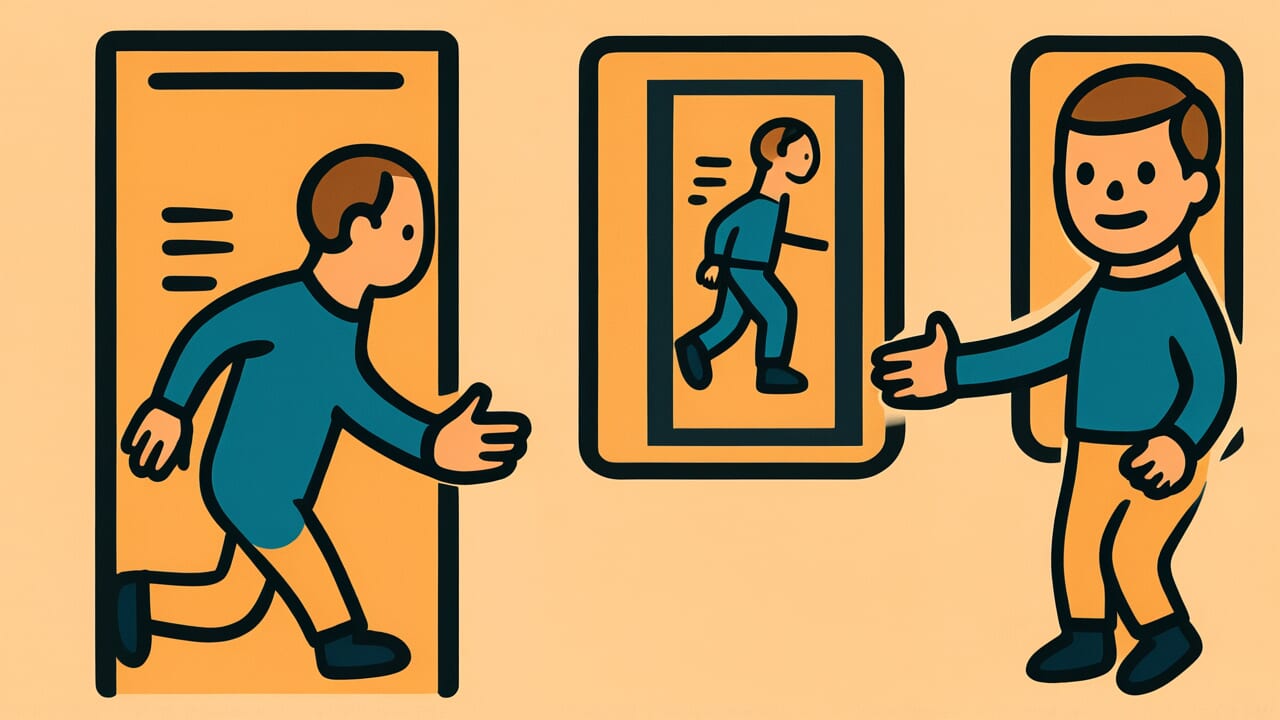How to Read “Right next, left next, without speaking”
みぎつぎひだりつぎものいわず
Meaning of “Right next, left next, without speaking”
“Right next, left next, without speaking” is a proverb that describes someone who moves around restlessly, going right and left, but never explains anything.
The person acts energetically and moves constantly. However, they don’t use words to communicate their intentions or reasons. This makes it impossible for others to understand what they’re thinking.
This proverb is used when describing someone who is quiet and whose actions are hard to read. They seem busy and move around a lot, but they don’t talk about their purpose.
They go here and there without explaining what they’re doing. The proverb captures this elusive type of person perfectly.
Even today, you might encounter someone at work or school who makes you think, “I have no idea what that person is thinking.”
They have plenty of energy and take action, but they lack communication. This confuses the people around them. This proverb accurately describes people who have this gap between action and words.
Origin and Etymology
There are no clear written records about the origin of this proverb. However, we can make interesting observations from the structure of the phrase itself.
The expression “right next, left next” represents inconsistent movement. Just when you think someone went right, next they go left. Just when they went left, next they go right.
The character for “next” repeats to emphasize how the person changes direction from moment to moment.
This proverb likely emerged from the townspeople’s culture during the Edo period. It probably started as a phrase for observing people’s behavior.
In the world of merchants and craftsmen at that time, judging people’s words and actions was crucial. This expression was probably used when evaluating someone who spoke little and whose thoughts were unclear.
The part “without speaking” is important. The person moves around, going right and left, but never explains their reasons or intentions.
In other words, they’re active in their actions but offer no verbal explanation. This makes it impossible for others to understand their intentions.
This proverb was likely passed down orally as a phrase showing sharp human observation. It’s a uniquely Japanese expression of subtle character evaluation.
It focuses on the mismatch between actions and words, or the absence of words altogether.
Usage Examples
- He’s right next, left next, without speaking, so nobody knows what he’s trying to accomplish
- That new employee is right next, left next, without speaking, so apparently even his supervisor has trouble guiding him
Universal Wisdom
The proverb “Right next, left next, without speaking” offers deep insight into the essence of human communication.
Actions alone cannot convey your true intentions. No matter how actively you move around, people can’t understand your intentions without verbal explanation. This is a timeless truth about human relationships.
What’s interesting is that this proverb includes not just “silence” but also the phrase “right and left,” suggesting lots of movement.
It doesn’t describe someone who sits quietly and still. Rather, it depicts an active person. In other words, it teaches that having energy and being understood are two separate things.
Humans are social creatures. Our actions gain meaning within relationships with others.
No matter how good your intentions are, if you don’t share them in words, others will see you as mysterious or confusing. Our ancestors understood this difficulty in human relationships.
This proverb has been passed down through generations because it conveys a universal truth. People can only understand each other when both actions and words come together.
In these few words, it beautifully expresses humanity’s fundamental loneliness and the need for communication to overcome it.
When AI Hears This
The human brain has limited processing capacity. When multiple complex tasks happen simultaneously, they interfere with each other.
The frontal lobe at the front of the brain contains both the motor cortex and Broca’s area. The motor cortex controls complex coordinated movements of the right and left hands. Broca’s area handles speech production.
These areas sit right next to each other. In other words, they compete for the same “brain real estate.”
Research shows that when performing tasks requiring different movements with both hands, blood flow concentrates in the motor control areas. Meanwhile, blood flow to language areas relatively decreases.
For example, complex bilateral movements like drawing clockwise circles with your right hand while drawing counterclockwise circles with your left hand require enormous computational resources. The brain needs these resources to maintain movement accuracy.
At this time, neural resources available for language processing become insufficient. Speaking speed slows down, or words become harder to produce.
What’s even more interesting is that this suppression happens unconsciously. The brain automatically prioritizes tasks, giving preference to hand movements that relate to physical safety.
The state that craftsmen described as “without speaking” was actually the result of the brain efficiently distributing tasks. The image of a craftsman working silently with concentration was, from a neuroscience perspective, the most rational form of work.
Lessons for Today
This proverb teaches modern people that taking action alone isn’t enough.
We grow up hearing that “taking action is important.” That’s certainly true. But this proverb points us one step further. If you’re going to act, communicating your intentions with words is equally important.
Modern society values teamwork. At work and at school, few jobs can be completed alone anymore.
No matter how good your purpose for acting, if you don’t share it, people around you can’t help you. In fact, they might even become suspicious of you.
Especially now that remote work has increased, the importance of communication has grown. Through a screen, your actions become even less visible. The habit of consciously explaining things with words is needed more than ever.
“Putting your thoughts into words” seems simple but is actually difficult. However, this small effort gives meaning to your actions and builds trust with those around you.
Value both actions and words. Become someone who treasures both.



Comments